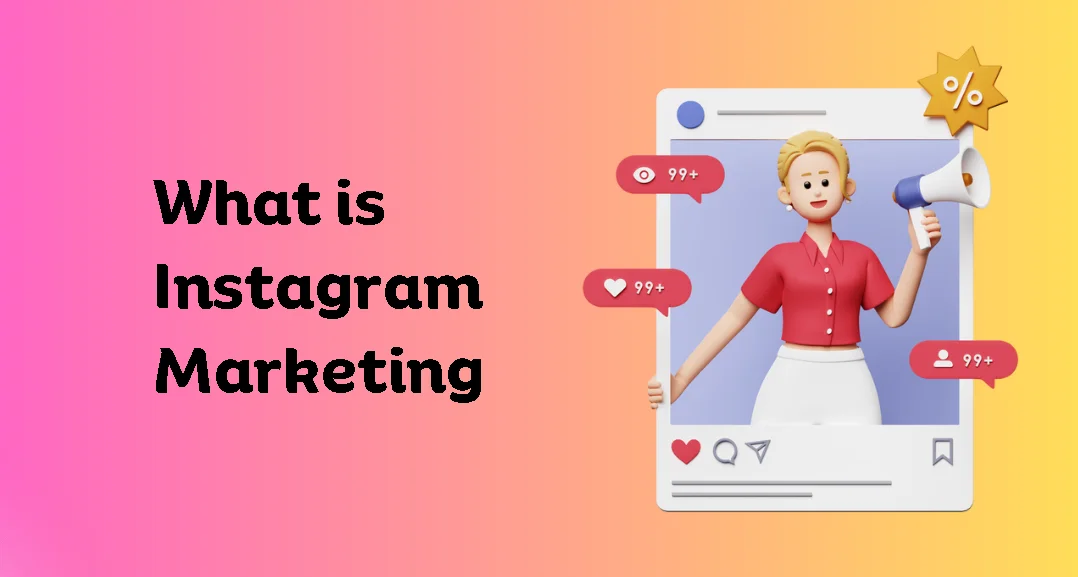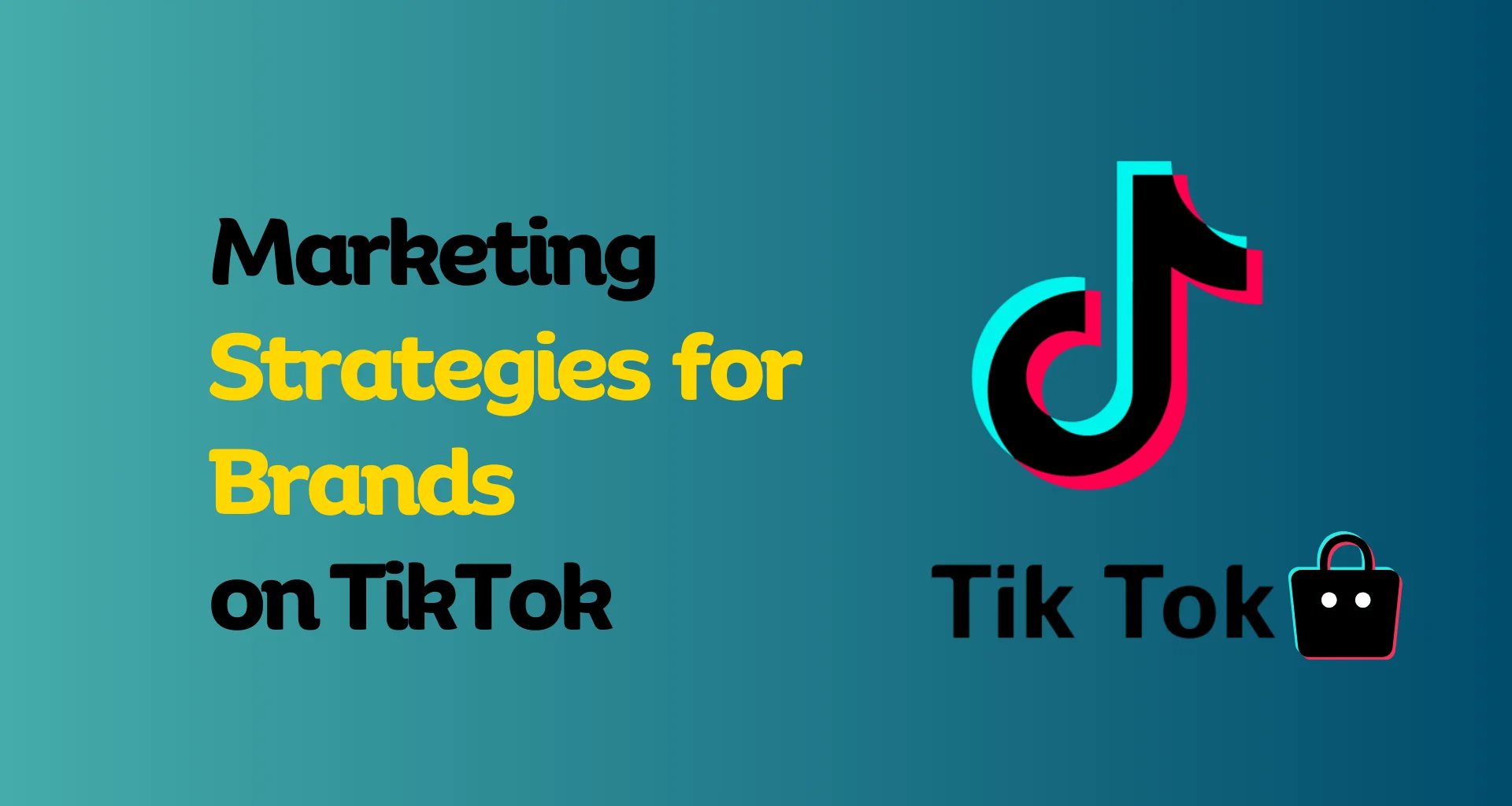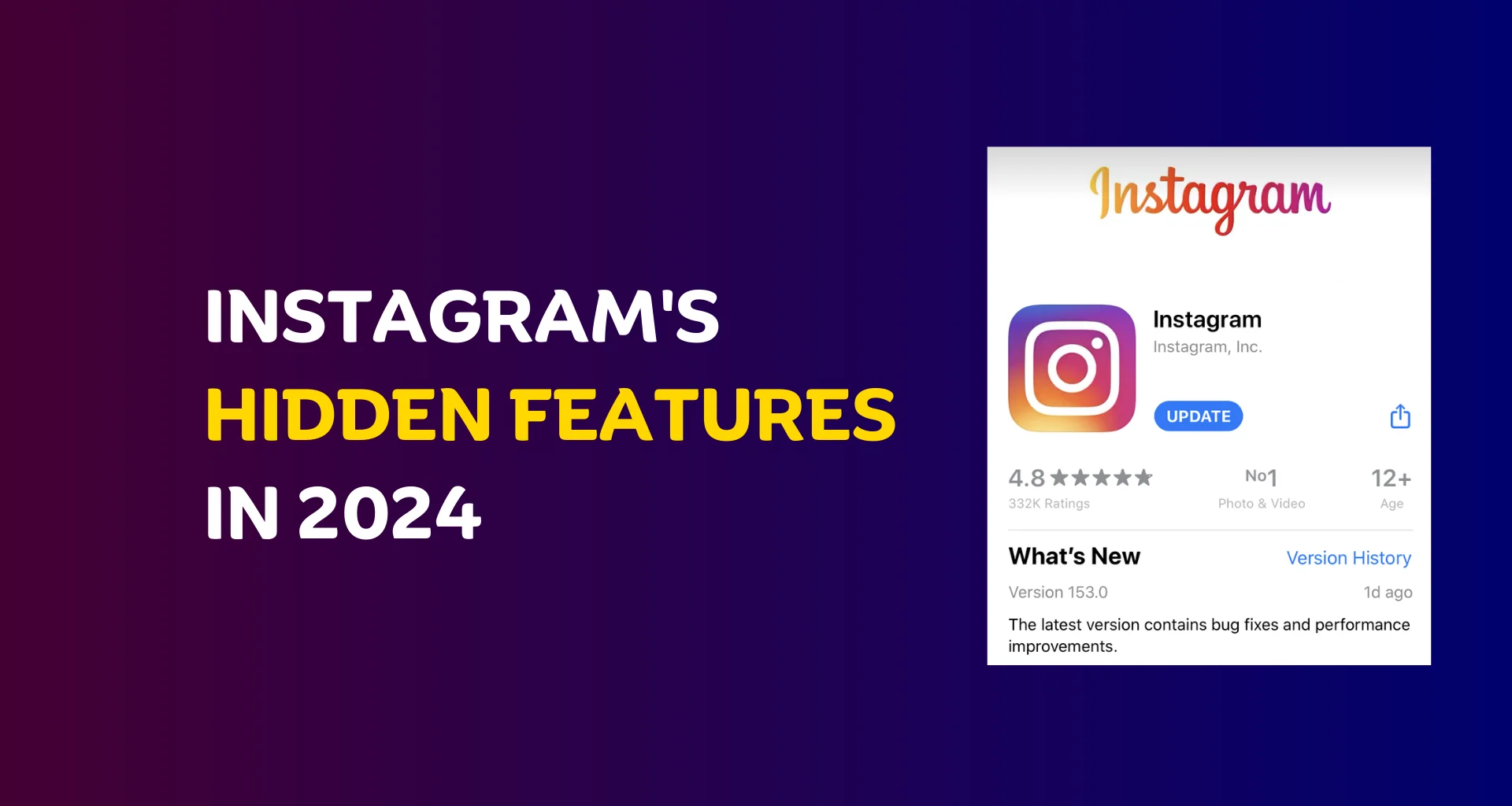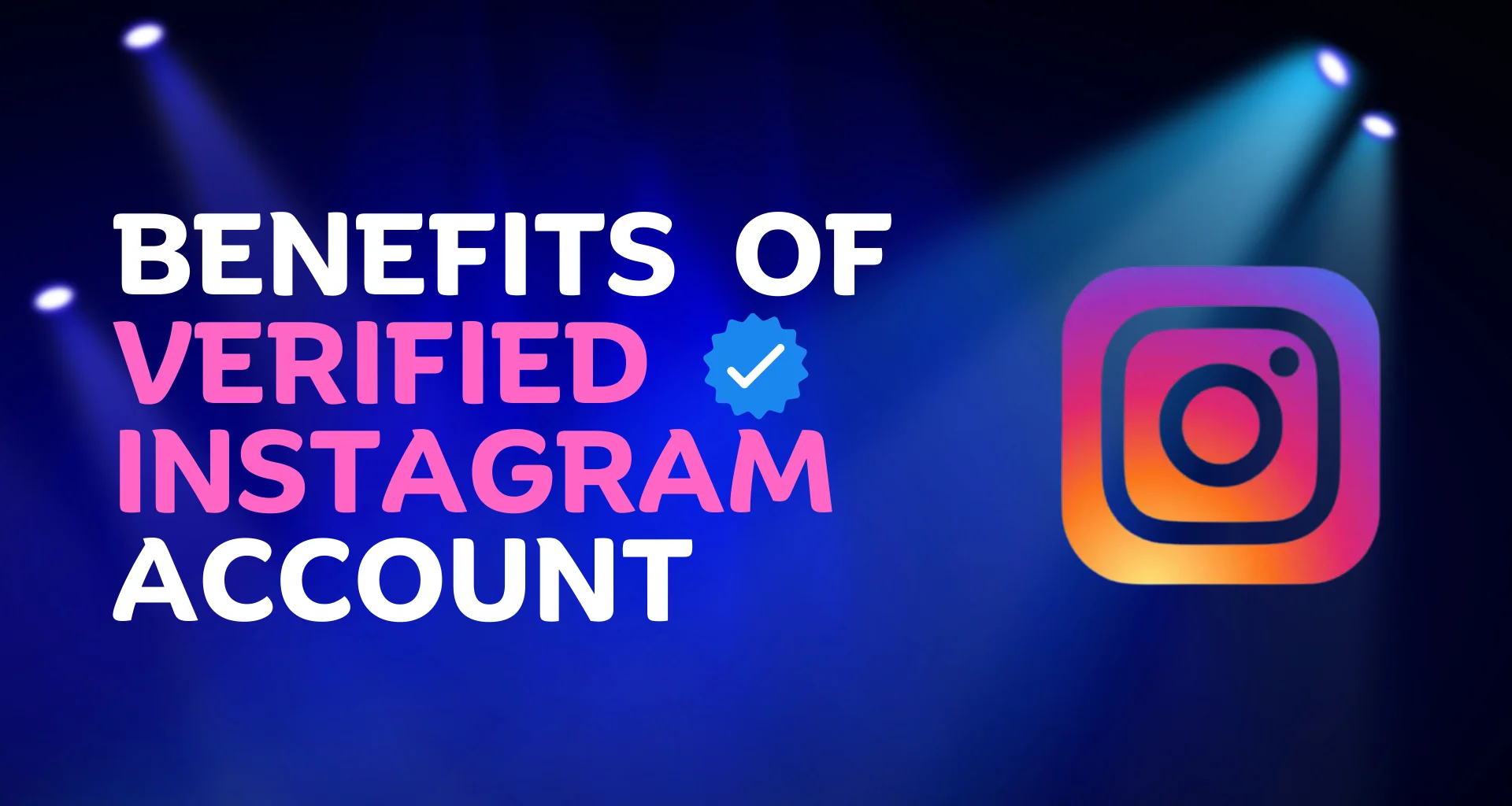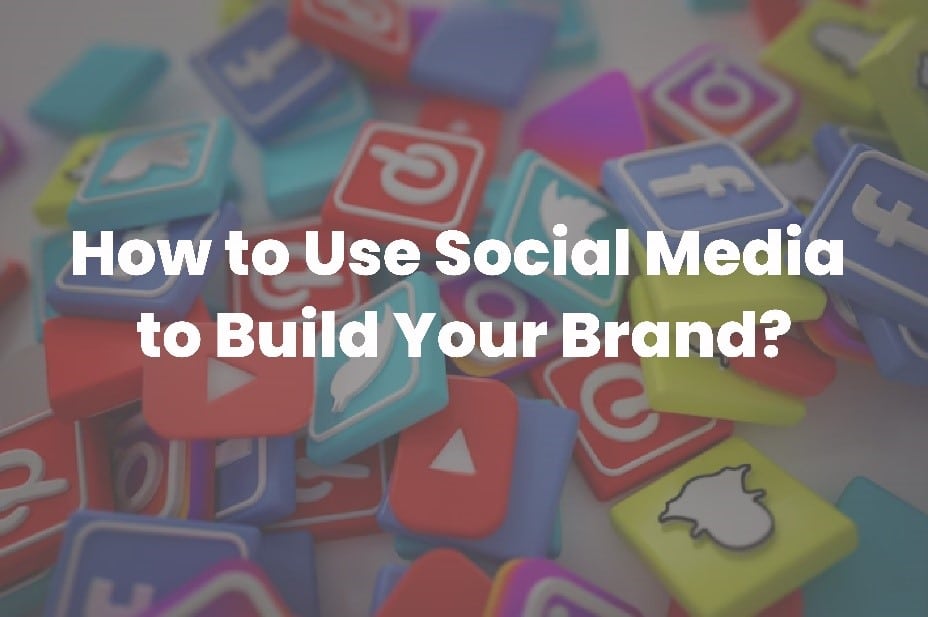What is Instagram Marketing and How Does
Instagram has grown into the second most influential social media platform behind Facebook, having over 2 billion monthly active users worldwide.
Instagram is known for its visually driven content. It offers huge potential for individuals and businesses to connect, share, and engage with their audience. For businesses and marketers, Instagram offers a unique space to showcase products, tell brand stories, and build strong relationships with potential customers.
What is Instagram Marketing?
Instagram marketing involves strategically using the platform to share or promote your products or services, build brand awareness, drive website traffic, increase content engagement, make sales, and gather audience feedback through polls and other interactive features.
How Instagram Marketing Works
Instagram marketing uses the platform’s diverse features to effectively engage with your target audience and promote your brand. There are various strategies to grow for every business on Instagram. Here we will share the essential one’s which should not be missed by anyone:
Setting Up Your Instagram Business Account
Creating a business account on Instagram is the first step toward unlocking features designed to help you grow your brand. Here are few steps to set up:
- Go to your profile settings and switch to a professional account.
- Select “Business” and fill in your details like industry, contact info, and location.
- Optimize your bio and profile picture to reflect your brand clearly.
Creating Engaging Content
High-quality content is crucial to capturing attention and driving engagement on Instagram. Eye-catching visuals and compelling captions help communicate your brand message and encourage interaction. Share behind-the-scenes content, daily updates, or polls to engage followers. Leverage trending music or effects to create short, dynamic videos. Use IGTV for longer video content like tutorials, interviews, or product showcases.
Maintaining a consistent brand voice and aesthetic ensures your content remains cohesive and recognizable, strengthening brand identity.
Engaging with Your Audience
Engaging with your followers is vital for building a community around your brand. Regularly interact with your audience to show appreciation and foster loyalty. Join discussions and trends relevant to your niche to stay visible and up-to-date. Running contests or giveaways is an excellent way to generate excitement and encourage user-generated content.
Leveraging Hashtags
Hashtags are essential tools for increasing your content’s discoverability. Identify trending and niche-specific hashtags that resonate with your target audience. Combining widely used hashtags with more specific ones helps you reach broader and more targeted audiences. Stick to a few strategic hashtags rather than overwhelming your posts with too many, which can dilute their effectiveness. We have a detailed guide on how to use hashtags; check it out for more details.
Collaborating with Influencers
Partnering with influencers can greatly expand your reach and credibility. Influencers bring access to their audience, which builds trust in your product or service and generates engagement for your brand. Look for influencers whose followers align with your target audience and whose content fits your brand. Set clear goals, offer creative freedom, and track performance to measure the success of influencer partnerships.
Running Instagram Ads
Instagram offers a variety of ad formats that allow businesses to showcase their products or services in engaging ways:
- Types of Instagram Ads:
- Stories Ads: Full-screen vertical ads that appear between users’ stories, ideal for short, impactful messages.
- In-Feed Ads: Sponsored posts that blend seamlessly into users’ feeds, great for promoting products or brand awareness.
- Reels Ads: Short, video-based ads that appear within the Reels feed, designed to capture attention with dynamic content.
Create eye-catching ads with a clear call to action (CTA) and compelling copy that speaks to your audience’s needs and interests. Experiment with different formats and visuals to see what resonates best with your target audience. Use Instagram’s advanced targeting options to reach specific groups based on demographics, locations, interests, or behaviors. Set custom audiences based on users who have engaged with your account or website.
Measuring and Analyzing Performance
To maximize your Instagram marketing efforts, analyze your ads performance and evaluate the success of your campaigns, focus on key metrics such as reach, engagement (likes, comments, shares), click-through rates, and conversions. Instagram offers valuable insights into your followers’ demographics and behavior, as well as post-performance data. Use these analytics to identify which content resonates best with your audience. Based on this information, adjust your strategy by producing more high-performing content, refining ad targeting, and optimizing your posting schedule for better results.
Conclusion
Instagram marketing presents endless opportunities for businesses to connect with their target audience, build brand awareness, and drive engagement. Setting up a well-optimized business profile, creating high-quality content, to engage with followers, and leveraging features like ads and hashtags, brands can establish a strong presence on the platform.
Consistently analysing performance through Instagram’s built-in tools and making data-driven adjustments will help you refine your approach and achieve long-term success. With the right strategy in place, Instagram can be a powerful tool to grow your brand and reach new heights.
Marketing Strategies for Brands on TikTo
TikTok, the popular short-form video platform, has seen a meteoric rise in popularity. Its engaging content and user-friendly interface capture audiences. Beyond its entertainment value, TikTok offers a powerful platform for businesses to reach a wide and diverse audience. Unlike traditional social media platforms, TikTok’s focus on short, attention-grabbing videos and its algorithm that prioritizes user engagement make it a unique space for brands to thrive.
This blog will explore practical strategies for businesses to leverage TikTok for marketing success. We’ll explore understanding your target audience, creating engaging content, optimizing your profile, collaborating with influencers, and measuring your performance.
1. Understanding Your Target Audience
Identifying your ideal customer on TikTok is crucial for tailoring your content and reaching the right audience. Analyze TikTok demographics and trends to understand who is active on the platform and what content resonates with them.
- Target Audience Analysis:
- Consider factors like age, gender, interests, and location.
- Research popular TikTok hashtags and trends related to your industry.
- Create buyer personas to represent your ideal customer and understand their needs and preferences.
By understanding your target audience, you can create content that resonates with them and effectively reach your desired market.
2. Creating Engaging Content
The cornerstone of successful TikTok marketing is creating content that resonates with your target audience. Short-form video content is the heart of TikTok, so focus on producing high-quality videos that capture attention and drive engagement.
- Embrace the Short-Form Format: TikTok’s algorithm favours short, attention-grabbing videos. Keep your content concise and impactful.
- Leverage Trending Sounds and Effects: Incorporating popular sounds, effects, and challenges can help your content reach a wider audience and increase engagement.
- Tell Stories: Humans are naturally drawn to stories. Use storytelling techniques to connect with your audience on an emotional level.
- Add Humor and Relatability: Injecting humour or creating relatable content can make your videos more shareable and memorable.
- Experiment with Different Formats: Explore various content formats like duets, stitches, and green screen effects to keep your audience interested and engaged.
3. Optimizing Your Profile
Your TikTok profile is your digital storefront. Make it visually appealing and informative to attract new followers and showcase your brand identity.
- Craft a Compelling Bio: Write a concise and engaging bio highlighting your brand’s unique value proposition. Use relevant keywords to help people find your profile.
- Choose a High-Quality Profile Picture: A visually appealing profile picture can make a lasting impression. Use a clear and professional image that represents your brand.
- Utilize Relevant Keywords and Hashtags: Use keywords and hashtags related to your niche to make your profile more discoverable.
- Leverage the Link in Bio Feature: Use the link in bio section to direct your followers to your website, online store, or other relevant platforms.
4. Leveraging TikTok’s Features
TikTok offers a variety of features that can help you enhance your content and reach a wider audience.
- Utilize TikTok Live for Real-Time Engagement: Live streams offer a great way to connect with your audience in real time and foster a sense of community.
- Explore TikTok Ads: Consider using TikTok Ads to promote your content and reach a larger audience. TikTok offers various ad formats, including in-feed ads, brand takeovers, and top-view ads.
- Use TikTok’s Analytics Tools: Track your performance and gain insights into your audience using TikTok’s built-in analytics tools. This data can help you optimize your content strategy and make data-driven decisions.
5. Collaborating with Influencers
Influencer marketing is a powerful tool for increasing your brand’s visibility and reaching new audiences on TikTok. By partnering with influencers who align with your brand values and target audience, you can create authentic and engaging content that resonates with your followers.
The collaboration boosts your credibility as followers trust recommendations from admired influencers, leading to higher engagement through increased likes, comments, and shares.
To maximize these benefits, choose influencers who resonate with your target audience. Identify influencers in your niche who align with your brand’s values and have strong engagement rates. Once selected, set clear goals, develop a content strategy, and agree on terms. Monitor the campaign’s performance to ensure it meets your objectives.
6. Engaging with Your Community
Building a solid community on TikTok is essential for long-term success.
- Respond to Comments and Messages: Show your audience that you value their feedback and engagement.
- Participate in Relevant Discussions and Trends: Join conversations about your niche and stay up-to-date with the latest trends.
- Run Contests and Giveaways: Encourage user-generated content and foster a sense of community.
7. Measuring and Analyzing Performance
Building a strong community on TikTok is crucial for long-term success. Responding to comments and messages shows that you value your audience’s feedback and are committed to fostering a connection. Participating in relevant discussions and staying current with trends helps you stay connected with your niche and maintain visibility. Additionally, running contests and giveaways can encourage user-generated content, further strengthening your community and increasing engagement.
Conclusion
TikTok marketing requires a combination of creative content, strategic planning, and consistent engagement. By following the above strategies, you can build a strong presence on the platform and achieve your business goals. TikTok is constantly updating, so it’s important to stay updated on the latest trends and best practices. Experiment with different approaches, analyze your results, and adapt your strategy. We encourage you to share your experiences and ask any questions you may have in the comments below.
Exploring Instagram’s Hidden Featu
Since its inception in 2010, Instagram has undergone a remarkable transformation, evolving from a humble photo-sharing app into a dynamic platform that caters to a diverse range of users. From individuals looking to connect with friends and family to influencers building their personal brands and businesses leveraging it for marketing, Instagram’s versatility is undeniable. With each update, Instagram introduces innovative features designed to enhance user experience, boost engagement, and empower creators. Whether you’re a seasoned Instagrammer or just starting your journey, understanding and leveraging these latest features can be the key to unlocking your full potential on the platform.
1. Expanded Carousel Limit: 20 Slides for More Creative Freedom
Previously, Instagram limited users to 10 slides per carousel post, which allowed for a decent amount of storytelling but often left users wanting more space to share their content. In 2024, Instagram expanded this limit to 20 slides, opening up new possibilities for creativity and engagement.
This expanded carousel feature is a game-changer for influencers, brands, and everyday users who want to convey more complex stories, showcase a more enormous variety of products, or provide detailed tutorials without being confined to a shorter format. For instance, brands can now share an extensive product lineup or a step-by-step guide in a single post. At the same time, influencers can delve deeper into their personal stories, sharing more photos and videos without worrying about running out of space.
2. Adding Notes to Posts and Reels
One of Instagram’s latest features is the ability to add notes to your posts and reels, a subtle yet impactful addition. These notes allow users to provide additional context, offer behind-the-scenes insights, or include promotional messages directly within their content.
For example, an influencer might use notes to share the inspiration behind a post, while a business could add special offers or product details that complement the visual content. This feature also helps keep audiences engaged by providing extra information that might not fit naturally into the caption.
To make the most of this feature, consider using notes to highlight key points or calls to action that might be overlooked. Additionally, adding personal anecdotes or exclusive tips in your notes can create a more intimate connection with your audience, encouraging them to interact with your content more deeply.
3. Pin Chats to the Top of Your Inbox
Instagram’s new pinning feature in Direct Messages (DMs) allows users to pin meaningful conversations to the top of their inbox. This feature is handy for managing communication in a cluttered inbox, ensuring crucial conversations are easily accessible.
For businesses, this means keeping priority clients or critical discussions front and center, reducing the risk of missing out on time-sensitive messages. Influencers can use the pinning feature to keep collaborations and brand partnerships organized. At the same time, regular users can pin chats with close friends or family members to ensure their messages don’t get lost in the shuffle.
To pin a chat, swipe right on the conversation and tap the pin icon. This small yet powerful feature enhances communication efficiency, making staying on top of your most important messages easier.
4. Promo Codes Directly on Instagram
Instagram has integrated a feature that allows businesses to share promo codes directly within the app, making it easier than ever for users to take advantage of special offers without leaving the platform. This feature streamlines the shopping experience and can significantly boost sales by reducing customers’ steps to redeem discounts.
Businesses can use promo codes in various ways, such as promoting a new product, encouraging repeat purchases, or rewarding loyal customers. Businesses can create a post, story, or reel featuring the promo code or include it in the notes section of their posts and reels to apply and share promo codes.
Here’s a quick step-by-step guide on how to apply and share promo codes:
- Create Your Promo Code: Set up the promo code in your e-commerce platform or Instagram Shop settings.
- Design Your Content: Create a post, story, or reel highlighting the promo code’s benefits.
- Add the Promo Code: Include the promo code in the caption, notes, or directly within the visual content.
- Share and Engage: Post the content and encourage followers to use the code by highlighting the limited-time offer or special deal.
This integration makes it easy for followers to make purchases without leaving the app, increasing the likelihood of conversion and customer satisfaction.
5. Instagram DM Themes: Personalizing Your Conversations
Instagram’s DM themes allow users to personalize their conversations by selecting from various custom themes that change the appearance of their chat backgrounds. This feature adds a layer of personalization to interactions, making them feel more engaging and tailored.
Themes range from simple color gradients to elaborate designs inspired by popular culture or seasonal events. To apply a theme, open a conversation, tap on the chat name at the top, select “Theme,” and choose from the available options.
For businesses, this feature can align chat aesthetics with their brand identity, creating a consistent experience across all touchpoints. Influencers can select themes that resonate with their brand or the vibe of a particular conversation. Regular users might enjoy switching up themes to reflect their mood or the nature of their interactions.
By allowing users to customize their messaging environment, Instagram DM themes enhance the user experience, making conversations more visually appealing and helping reinforce brand identity subtly yet effectively.
6. Group Chat Conversation Starters in Notes
Instagram’s new feature of adding conversation starters in Notes for group chats is designed to spark engagement and foster community interaction. This feature allows users to post a short message or question at the top of the group chat, serving as an icebreaker or a prompt for discussion.
By introducing a conversation starter, group members are likelier to engage with the chat, keeping the conversation lively and interactive. This feature is handy for communities, clubs, or teams that rely on group chats to stay connected, as it encourages participation from all members.
Tips for Using Conversation Starters:
- Ask Questions: Pose a question relevant to the group’s interests to kickstart a discussion.
- Share Updates: Use the feature to share quick updates or news everyone in the group should know about.
- Start a Poll: Encourage interaction by asking group members to vote on a decision or share their opinions on a topic.
By strategically using conversation starters, group admins can ensure that chats remain active and engaging, fostering community among members.
7. Zooming In on Instagram Profile Pictures
One of the most requested features, the ability to zoom in on Instagram profile pictures, is now available. This new feature enhances the user experience by allowing better visibility of profile images, which were previously fixed in size and could only be viewed on a small scale.
This feature is particularly beneficial for users who want to see details in profile pictures, such as logos for business accounts or intricate designs in personal photos. For businesses, this means potential customers can now take a closer look at your brand’s logo or other profile elements, which can help build brand recognition and trust.
For personal accounts, zooming in allows followers to appreciate better profile photos, especially those with detailed imagery or essential visual elements. This feature also encourages users to pay more attention to their profile pictures, ensuring they are high quality and represent their identity or brand.
8. Other Noteworthy Updates in 2024
In addition to the significant features mentioned, Instagram has introduced several smaller updates in 2024 that contribute to the overall user experience:
- Enhanced Reels Editing Tools: New editing capabilities in Reels allow for more creative control, such as advanced trimming options and additional effects.
- Improved Accessibility Features: Instagram has added new tools to make the app more accessible, including enhanced screen reader support and customizable text sizes.
- Updated Explore Page Algorithm: The Explore page now better reflects user interests, with improved content recommendations based on engagement and search history.
While smaller in scale, these updates collectively enhance Instagram’s functionality and user-friendliness, ensuring that It remains a cutting-edge tool for content creators and everyday users.
Conclusion
Staying updated with the latest Instagram features is essential for making the most of the platform. Whether you’re a brand looking to connect with your audience, an influencer aiming to enhance your content, or a casual user enjoying the app, understanding and utilizing these new tools can significantly improve your Instagram experience.
Use these hidden features to see how to elevate your social media strategy. Don’t forget to share your experiences or favorite new features in the comments below—let’s keep the conversation going and help each other make the most of what Instagram offers in 2024!
The Benefits of Being Instagram Verified
Standing out on social media can be challenging. Amid the sea of users, the blue verification checkmark on Instagram has become a coveted symbol of credibility and authenticity. But what exactly are the benefits of being verified on Instagram? We’ll discuss the key advantages this small but significant badge can bring to your personal or business profile.
Enhanced Credibility and Trust
One of the most immediate benefits of being verified on Instagram is the credibility it brings. The blue checkmark signals to your followers and potential followers that Instagram has confirmed your account as the genuine presence of a public figure, celebrity, brand, or notable entity. This verification helps eliminate doubts about the authenticity of your account, making users more likely to trust and engage with your content.
Increased Visibility and Reach
Instagram’s algorithm favors verified accounts, often prioritizing their posts in users’ feeds and search results. This increased visibility means your content is more likely to reach a broader audience. This can translate into greater brand exposure and an expanded follower base for businesses and influencers, ultimately driving more engagement and potential business opportunities.
Access to Exclusive Features
Being verified on Instagram unlocks access to exclusive features unavailable to regular users. These features can include early access to new tools and updates, adding links to Instagram Stories (even if you have fewer than 10,000 followers), and enhanced insights and analytics. These tools can be incredibly valuable for businesses and influencers looking to maximize their social media strategies.
Protection Against Impersonation
Impersonation and fake accounts are common issues on social media. Having the blue checkmark helps protect your identity or brand by distinguishing your official account from potential imposters. This safeguards your reputation and ensures that your followers interact with the real you, thereby fostering stronger and more authentic connections.
Greater Engagement and Influence
Verified accounts often experience higher levels of engagement. The blue checkmark adds an element of prestige that can attract more followers, likes, comments, and shares. For influencers and businesses, this increased engagement can enhance your influence and authority within your niche, leading to more lucrative partnerships and collaborations.
Boosted Brand Authority
For businesses, the verification badge is a powerful indicator of legitimacy. It reinforces your brand’s authority and professionalism, making attracting and retaining customers easier. A verified account can also enhance your brand’s image in the eyes of potential business partners, investors, and the media, opening doors to new opportunities and growth.
Improved Marketing Opportunities
With higher engagement rates and increased visibility, verified accounts appeal more to brands looking for influencer partnerships. As a verified influencer, you can command higher fees for collaborations, sponsorships, and advertisements. Brands are more likely to invest in partnerships with verified accounts, knowing they are dealing with a credible and influential entity.
Enhanced Customer Interaction
For businesses, being verified can improve customer interaction and satisfaction. Customers are likelier to trust and reach out to verified accounts for customer service inquiries, feedback, and support. This can enhance your brand’s reputation for reliability and responsiveness, fostering loyalty and long-term customer relationships.
Conclusion
The benefits of being verified on Instagram extend far beyond the prestige of the blue checkmark. From enhanced credibility and trust to increased visibility, engagement, and marketing opportunities, verification can significantly elevate your online presence. Whether you are an individual influencer or a business, securing Instagram verification is a powerful step toward building a stronger, more impactful social media presence. Embrace the advantages of the blue checkmark and watch as your influence and authority grow on one of the world’s most popular social media platforms.
How Can You Determine the Return on Inve
In the world of social media marketing, although the internet made it much easier, understanding the complex language of ROI (Return on Investment) can be a challenging task sometimes for both marketers and businesses. It is crucial to understand how to measure the success of your social media efforts to guarantee that every dollar spent provides significant returns. Join us as we embark on a mission to simplify the process of calculating ROI in the digital world.
Our goal is to provide you with all the answers you need to refine your tactics and optimize your social media marketing. By the end of this journey, you will have the knowledge necessary to calculate your ROI and determine the effectiveness of your social media efforts, ultimately ensuring your success.
Navigating the ROI Conundrum
Social media has become a massive platform where billions of people share, like, and comment on endless digital content. However, one burning question that echoes stronger than ever in the big theatre of social media marketing is – how can we measure the ROI of our social media endeavors?
To answer this question, we need to understand the complicated balance of data, engagement, and conversions, rather than focusing solely on the numbers. It is crucial to first understand the importance of ROI and how it affects the course of our digital efforts before we set out on this journey.
Together, let’s overcome this confusing task and come away with a thorough understanding of how to accurately calculate the return on investment (ROI) for your social media marketing efforts.
Social Media ROI: Uncovering the Mysteries
Return on Investment, or ROI, is the important indicator that evaluates how well your marketing initiatives performed with the resources used. In simpler terms, it answers the fundamental query: “Are the resources you’re investing in our social media campaigns producing visible results?” Understanding the ROI is the compass

That defines the strategies you use, whether your goal is to raise brand awareness, improve website traffic, or increase sales.
Understanding the ROI Calculation

Now that we understand what ROI is, let’s examine how to measure ROI in the context of social media marketing. ROI is mainly a calculation that calculates the net profit from your marketing efforts. Here is the equation:
ROI is equal to 100 times (Net Profit / Cost of Investment).
How Can This Formula be Used in Social Media Marketing?
To get an in-depth understanding there are certain terms you need to be aware of,
Net Profit: The money made as an outcome of your social media marketing efforts is generally referred to as the net profit. This includes overall sales revenue, lead-generating revenue, and any other tangible result.
Cost of Investment: Any expenses related to your social media efforts are included in the cost of investment. This covers expenses for tools, wages for employees, and content creation costs.
You could assess the outcome of your efforts by using this formula to calculate the effectiveness of your social media marketing efforts. A good ROI shows that your campaigns are generating returns on your investment that are higher than they were, whereas a negative ROI shows that improvements are required.
Setting Clear Goals
Setting specific and tangible goals for your social media campaigns is essential before you analyze any data. The goals you set will have an impact on the measurements you take to calculate ROI. Establishing certain goals enables you to match your approach with your desired results, whether your goal is to raise brand awareness, increase website traffic, or enhance sales.

Why are setting specific goals essential for calculating ROI? You may ask.
The basis of measuring success is to have clear objectives. When your goals are clear, you can monitor the exact metrics that are considered to be more significant to your company. For instance, you would concentrate on measures like click-through rates and visits to your website, if your objective was to boost more website traffic.
Social Media Offers a Range of ROI Metrics
The success of your social media marketing efforts shouldn’t be measured solely by revenue generated from sales. There are other metrics that you should consider to determine the overall impact of your campaigns. Here are some key metrics that you should keep in mind:
Conversion Rate: This metric measures the percentage of users who take a desired action, such as making a purchase or signing up for a newsletter, after interacting with your social media content.
Click-Through Rate (CTR): CTR tracks the number of clicks on your social media posts or ads relative to the number of impressions. It indicates the effectiveness of your content in driving traffic to your website.
Engagement Rate: Engagement rate quantifies the level of interaction your content receives, including likes, comments, shares, and retweets. It reflects the extent to which your audience is actively participating with your brand.
Customer Lifetime Value (CLV): CLV estimates the long-term value of a customer, considering their repeated purchases and loyalty. Understanding CLV is crucial for assessing the long-term impact of your social media efforts.
Cost per Click (CPC) or Cost per Acquisition (CPA): These metrics help you evaluate the efficiency of your advertising campaigns by measuring the cost associated with each click or acquisition.
ROI Analytics and Tracking Tools
These monitoring tools can help you determine the ROI of your social media campaigns by providing you with valuable information about user behavior, engagement, and revenues. By analyzing this data, you can assess which strategies are working and which ones need improvement. This allows you to make better-informed decisions about your social media campaigns, which can help you improve your efforts and ultimately achieve greater ROI. Platforms like Google Analytics, Facebook Insights, and Instagram Insights are just a few examples of tools that can provide you with the data you need to make these informed decisions.

Using Attribution Models to Value Interactions
Calculating ROI in the world of social media marketing requires a clear understanding of attribution models. Attribution models assign value to the different interactions a user has with your brand before the conversion. The customer’s journey can be analyzed using various models, including first-click, last-click, or multi-touch attribution.
How Can Attribution Models Improve Measuring ROI?
Attribution models assist you in assigning value to various touchpoints by taking into account the whole customer path to conversion. This enables you to understand how your social media efforts as a whole have affected the conversions.
ROI Optimization Strategies
Evaluating past performance is not the only requirement that needs to be improved for future campaigns. You need to gain insights from past performances and use them to enhance future campaigns. Here are a few effective strategies that can aid in boosting your social media ROI.

- A/B Testing: Experiment with different ad creatives, copy, and targeting options to determine what resonates best with your audience. Conducting A/B testing helps you to make your strategies better for achieving higher ROI.
- Audience Segmentation: Divide your audience into segments based on demographics, behavior, or preferences. Altering your content to each segment can result in more effective campaigns.
- Content Strategy: Investing in high-quality and engaging content that resonates with your audience can work wonders for you. Providing valuable content increases user engagement, which will eventually result in higher conversions.
- Budget Allocation: Strategically dividing up your budget is necessary. Focus on the platforms and campaigns that deliver the best ROI. Regularly assess and portion out your budget based on performance.
- Landing Page Optimization: Assuring your landing pages are optimized for conversions can make all the difference. Make sure to keep them simple, clear, and easy to navigate.
Conclusion
The struggle to perfect the skill of calculating ROI never ends. It takes a thorough understanding of your goals, a sharp eye for vital metrics, and the capacity to change or take your strategies according to the information you receive. so When you begin your journey on this road, keep in mind that ROI is not a static figure; rather, it is a representation of your efforts to engage with your audience, develop relationships, and ultimately produce significant results.
Therefore, conceive yourself with the skills, information, and motivation required to figure out the ROI conundrum. Understand the constantly changing nature of social media and take advantage of it. Access, analyze, grow, and then set out to sail once again because your quest for mastering the skill of ROI is an adventure with no bounds in this endless ocean of data as well as interactions.
As you learn new insights, you will continue to succeed and will be able to generate greater profits.
How to Safeguard Your Presence on Social
In today’s world, social media has become an integral part of our lives. However, it also comes with some drawbacks such as scams and identity thefts. To protect your safety and security on social media platforms, we have shared some important strategies that will help you stay secure while browsing the internet. Join us as we teach you these strategies to safeguard your social media presence and surf the internet with confidence and peace of mind.
If you are wondering how to protect your online presence whether it is on social media or while surfing the internet, here are a few tricks and strategies that’ll help you protect your online presence.
What Should We Do to Guarantee Our Safety on Social Media First?
It’s crucial to have a good understanding of the online world, especially when it comes to social media. Every social media platform has its own unique set of rules, guidelines, and threats. Therefore, it’s important to get familiar with the platform you’re using right from the start. Make sure to learn about their privacy settings, complaint processes, and terms of service. Knowing this information is the first step toward ensuring your online safety and security.
Building a Stronger Social Barrier
Just as a castle is strengthened by its walls, your online safety relies strongly on your privacy settings. Follow these steps to fortify your social barrier

Privacy Settings: Customize your privacy settings to control who can see your posts, access your personal information, and send you friend or follow requests. Restrict access to only those you trust.
Two-Factor Authentication (2FA): Enable 2FA wherever possible. This additional layer of security ensures that even if your password is hacked somehow, an extra code or verification step is required for access.
Regular Password Updates: Change your passwords occasionally, and use strong, unique combinations of letters, numbers, and symbols. Password managers can help you keep track of them.
Beware of Third-Party Apps: Be cautious about granting access to third-party applications through your social media accounts. Review and revoke access to apps you no longer use.
Guarding Against Fraud and Scams
Fraud attacks and scams are the lurking dangers of the online world. These deceptive tactics can trick you into revealing sensitive information or clicking on malicious links. Here’s how to steer clear:

Be Skeptical: Approach anonymous messages, emails, or friend requests with skepticism. Verify the sender’s identity before taking any action.
Check URLs: Move your cursor of the mouse over links to preview the destination URL before clicking. Ensure it matches the legitimate website’s address.
Avoid Sharing Personal Information: Never share personal or financial information via direct messages or emails. Legitimate companies won’t request sensitive details in this manner.
Stay Informed: Stay updated on common scams and fraud techniques. Awareness is your best defense.
The Increased Awareness of Cyber Security
Cyber hygiene protects your online well-being in the same way that your hygiene protects your physical health. A good cyber safety routine includes:

Regular Updates: Keep your computer’s operating system, applications, and antivirus software on your device up to date. Security patches are frequently included as part of updates.
Safe browsing: Be careful of clicking on links, particularly those published by unidentified parties or in suspicious situations.
Limit the sharing of personal information on your public profiles, such as the location of your residence, phone number, or financial information.
Reporting Suspicious Activity: Inform your platform’s authorities if you come across harassment, hate speech, or abusive content.
Why is Good Cyber Hygiene Important for Safety?
Cybersecurity helps prevent unauthorized access to your accounts, protecting your safety, just like washing hands to prevent illness.
Awareness of Social Engineering and Alertness
Fake Friendships and Impersonation are two common social engineering tactics that cybercriminals use to manipulate their victims. They often create fake accounts that appear legitimate, so it’s important to be cautious before accepting friend requests or interacting with unknown accounts. Make sure to check the legitimacy of accounts, especially those that claim to be associated with well-known people, companies, or brands, and look for badges of verification when required.
Moreover, cybercriminals often use psychological strategies to win your confidence or pity. Therefore, it’s essential to be cautious about requests for help or stories of sudden feelings. Finally, it’s important to teach young people about web-based grooming methods and the importance of keeping personal information private.
Being a Responsible Online Citizen
In the world of social media, your actions can have consequences not only for your safety but also for the safety of others. To be a responsible virtual citizen, you should follow these guidelines:

1. Respect Boundaries: Always be considerate of other people’s privacy and boundaries. Before sharing their pictures or information, make sure you have their consent.
2. Verify Information: It is essential to make sure that the news or information you share is accurate. Misinformation can quickly spread and have adverse consequences in the real world.
3. Promote Positive Behavior: Contribute to developing a positive online community by engaging in enjoyable conversations and refraining from bullying or hate speech.
4. Educate Others: Inform your friends and family members, especially those who might be less familiar with technology, about internet safety and security.
Conclusion
Though the internet and social media are great tools to promote your brand or services, they also have their downsides. It’s important to safeguard your online presence, and this is not just your responsibility alone, but rather a collective responsibility. By implementing the security measures we’ve taught you, you can protect yourself in the virtual world and surf with peace of mind. However, in the unfortunate event of identity theft or hacking, it’s crucial to immediately inform the relevant authorities, deactivate or delete the account, and inform your friends and family to prevent further damage.
It’s important to remember that online safety is a repeat process, rather than a one-time fix. The key is to stay informed, adapt to new threats, and educate others. By working together, we can ensure that our safety and security are always protected on the internet and social media.
How Can You Use Social Media for Profess
Social media is more than simply a place to share funny stories and pictures from vacations, it has evolved over time and now in today’s interconnected world, it has become a powerful weapon through which so much more could be achieved.
It has become an effective tool that can influence both our personal and professional lives. Social media could serve as the hidden tool for your professional growth, helping you grow your professional career, build your network, or keep you updated in your field.
In this article, we’ll be looking at how to use social media wisely to progress in your career.
Developing a Strong Online Presence
The first step in your social media professional development path is to establish a compelling online presence. Your online identity matters as it serves as your online business card and could open up the door to opportunities you were unaware of.
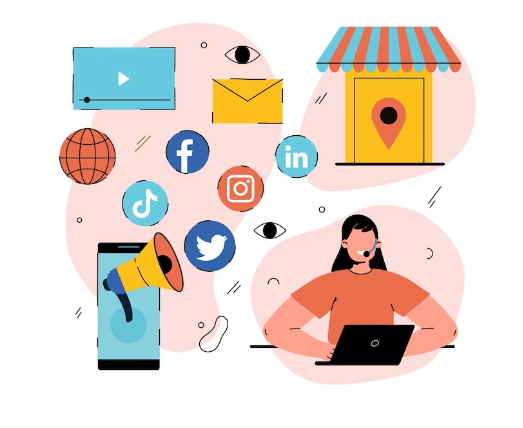
Create or update your profiles on websites like LinkedIn, Twitter, and even Instagram if your field is more visually driven. Create an interesting bio that highlights your experience and goals, and use a professional profile photo. Keep in mind that your internet presence should accurately represent your professional brand.
Connecting with the Right People
There are a ton of possible links and connections available through social media. However, you must build relationships with those who share the same goals as you. Choose LinkedIn as the ideal platform for establishing connections with friends, mentors, and business influencers LinkedIn is used by professionals all around the globe so it will be much easier for you to find the ideal people that you may be looking for.

Look out for and follow thought leaders in your field of interest. Like, share, and comment on their posts to interact with their content. This not only keeps you informed of market trends but also makes you a las an active participant in the conversation.
Joining Relevant Groups and Communities
Almost all social media platforms offer groups or communities where professionals can come together to discuss challenges relevant to their industries. LinkedIn offers groups and discussions, Reddit has subreddits for almost every niche, and Facebook has groups. Join these groups to share thoughts, seek bits of advice, and stay updated.

Share your expertise and knowledge with these groups to make a meaningful contribution. Always keep in mind that professional development is a two-way process. You develop personally and professionally while helping others.
Creating and Sharing Content
Creating and sharing content on social media is one of the best ways to use it for professional development. Create a blog, publish articles, or share pieces of advice on social media about your field of expertise. In addition to showcasing your knowledge, content draws in people with similar interests.

Sharing clear, and precise informative views and articles on platforms like LinkedIn and Twitter are perfect for sharing. To make your content more visible, use hashtags that relate to your niche. The more high-quality content you create, the more your reputation as an expert in your field will grow.
Engaging in Thoughtful Discussions
Social media isn’t simply a place to share your opinions; it’s also a place to have deep conversations. Participate in discussions that involve your field or interests. Don’t be hesitant to share your opinion, even if it disputes what most people believe just make sure that your facts and figures are correct.
Always be respectful and open to other people’s perspectives. You may improve the arguments you make and increase your knowledge by participating in meaningful debates.
Making the Most of Learning Opportunities

Online workshops, live sessions, and course offerings are available on many social media websites. For instance, LinkedIn Learning offers a wide range of courses on different topics. Your professional development will benefit significantly from the fresh skills and information that you can get by enrolling yourself in these courses.
Networking Outside the Box
Geographical hurdles are removed thanks to social media, enabling you to make connections with professionals in your field all across the world. For your career, this worldwide access might be a game-changer. Engage in professional conversations with people from various backgrounds to gain new perspectives.
Keeping a Professional Attitude
Even though social media can be a useful tool for professional development, it’s still important to act professionally all of the time. Sharing content that can damage your reputation should be avoided from being offensive or controversial. In conversations, be aware of your words and tone because they represent your professional attitude.
Act of Balancing
Finally, it’s important to maintain a balance on social media between your personal and professional lives. Although occasionally sharing private information is acceptable, keep in mind that your main objective is professional advancement. Concentrate on contacts and content that align with your career objectives.

In conclusion, social media has developed into a versatile tool that can help you progress in your career if used the right way. The key to using social media effectively is to establish a strong online presence, build vital connections, participate in meaningful conversations, and take advantage of learning opportunities. That means you can completely utilize social media to develop your career and accomplish your career objectives by sticking to all of these strategies and operating professionally. Never underestimate the power of your online identity because it could be the key to opening up new career options for you.
How to Use Social Media for Your Persona
Indeed social media has become an important tool in today’s modern era. It has become more than just a socializing or entertaining platform. Fortunately, social media has become a potent tool for personal growth and development. Social media provides tremendous potential for one’s personal growth and development.
Social media can inspire self-improvement since it offers the chance to interact with like-minded people, access beneficial resources, and share ideas, thoughts, and information.
In this article, we’ll explore the idea of self-growth and development and how you can use social media to your advantage.
Take Control of Your Social Media Feed
Your thoughts and opinions are molded by the stuff you take in. Organize your feed to take control of your social media experience:

Follow people on social media who share the same goals for personal growth, such as helpful writers, motivational speakers, or entrepreneurs.
Accounts that frequently share hindering or negative information should be unfollowed or muted.
To expand your horizons, search for different points of view and voices.
You can create an environment supporting your personal growth by deliberately modifying your feed.
Join Communities of the Same Interest
Many groups and communities are available on social media platforms that are dedicated to specific interests or targets:

Join groups that relate to your areas of interest, whether they are business, fitness, meditation, or something else entirely. Joining groups that share like-minded interests can help you to self-develop as well as find more people who share the same interests as you, which can help you learn new things related to your area of interest.
Being a part of such groups can provide priceless knowledge, help, and motivation.
Learn and Share Knowledge
There are numerous opportunities to learn on social media:
Follow influential people and experts in your field and learn from them.

Share your knowledge, experiences, and things that you learned so that other people can benefit from it.
To develop new skills, take part in online seminars, live streaming, and enroll yourself in online courses.
You can increase your knowledge and grow into a useful asset for others by engaging in an ongoing cycle of learning and sharing.
Set Goals and Track Progress
Setting goals is a key part of personal development:
Make public postings of your goals and ambitions on social media so you can keep yourself motivated.
Share progress updates, celebrate your achievements, and reflect on the lessons you learned.

Encourage those who follow you to successfully establish and achieve the goals they have by building an online community that is encouraging.
By setting and sharing your goals, you not only keep track of your progress but also inspire others on their journeys.
Practice Mindful Consumption
Mindful consumption means being conscious of what you consume on social media:
To avoid excessive browsing, set boundaries and limit your scrolling time.
Take breaks from social media to recharge and reflect positively on your thoughts.
Take occasional breaks from your electronic devices and engage in digital detoxification to recharge your batteries and regain your focus.
By engaging in mindful consumption, you can make sure that your use of social media aligns with the goals you have for your growth.
Seek Mentorship and Guidance
Coaches and mentors are everywhere on social media platforms:
Find people who have accomplished the goals you have and ask them to be your mentors.
Connect with mentors by joining their groups or courses or sending them direct messages.
If you want to speed up your personal growth, be open to helpful criticism and guidance.

Social media mentoring can offer personalized guidance as well as quick ways to succeed.
Build Resiliency and Positivity
Social media can sometimes become a breeding ground for negativity and comparison:
By concentrating on improving yourself and learning lessons from challenges and losses, you can build strong resilience.
Share and acknowledge all of your accomplishments, no matter how minor or major they are, and be humble about it, to show your thankfulness.
Encourage people by making positive comments and providing positive thoughts and suggestions.

Positivity on social media promotes not only your personal development but also builds an optimistic online community.
Reflect and Writing Online
Social media can be used as a digital notebook throughout your journey of personal growth and development:
Share with your audience about your views, eureka moments, and unique ideas.
If you want to keep the contents of your writings more public, use specific hashtags or, if you want to keep it more concealed set up a private account.
Encourage an atmosphere of self-improvement, and invite your audience to share their thoughts and experiences.
By documenting your journey, you can expand your perspective, keep track of your growth and development, and motivate others to start their own personal growth journeys by reflecting upon your trip.
Conclusion
In conclusion, social media platforms have the potential to be powerful tools that can foster one’s personal growth. You can benefit from the opportunities offered by social media to accelerate your journey toward personal development by structuring your social media network, gaining knowledge, creating objectives, participating in discussions, and actively giving back to your community. So, do you have what it takes to utilize social media to its fullest extent as a tool for personal growth?
How to Use Social Media to Build Your Br
In today’s world, where everything is connected through the internet, the virtual world is more than just an online world. It reflects our personality, beliefs, and how we interact with the world.
In this world where social media is the pinnacle of all platforms, personal branding is more the process where you can create your identity for yourself and influence the way this world perceives you. But then the question that arises is:
How Can You Use Social Media to Create and Enhance Your Brand?
Worry not, Join us on a transformative journey through the rough seas of personal branding in the digital era. In this article, we’ll teach you strategies, insights, and tactics that will help you sail thoroughly through the ocean of social media. You will be equipped with all the necessary pieces of information, tools, and resources to become an expert in personal branding.
Throughout this journey, you’ll learn how to build a unique online presence and create meaningful connections with your audience. You’ll discover how to build a

Compelling a brand story that relates to your target audience, using data-driven steps to strengthen your digital marketing strategies and leverage your social media platforms to build your brand. By the end of this article, you’ll find creating the social media brand wasn’t that hard after all though it takes time and a lot of hard work.
So what are you waiting for, Get ready and set sail let’s help you build up a personal brand!
What is Personal Branding Exactly, and Why is it Important?
Personal branding is a strategically planned method of creating and managing your online brand to represent a particular image or identity of you. To create a unique and compelling persona, you need to identify and communicate your special qualities, values, and skills. Personal branding makes you stand out in the flock of content and puts you in control of your online existence.
Making Your Personal Brand Story
Your brand needs an integrated story, just as a ship needs a strong structure and a straightforward course. Start by addressing these important questions to yourself:

How Do You Feel? Examine yourself closely and acknowledge your strengths, passions, and values. What distinguishes you from other professionals who specialize in your field?
What Do You Hope To Achieve? What are your long-term objectives, and how do they fit with your personality and your field of expertise?
What exactly is Your Targeted Market? Understand the people you wish to connect with and engage with them as your target audience. What are their preferences, requirements, and challenges?
Why is it so Important to have a Personal Brand Narrative?
Your brand is shaped by the story you tell. It drives your interactions, decisions, and content to make sure every part of your online presence relates to your originality and purpose
Choosing the Right Social Media Platforms for Your Brand
In today’s world, social media is an excellent way to build and strengthen your brand. However, with so many social media platforms to choose from, it’s important to select the right medium that aligns with your brand objectives. Here are some factors to be considered when selecting your platforms:

1. Your Target Audience: It is crucial to determine where your audience spends the most time. For instance, if you’re a professional, LinkedIn might be ideal for you, while Instagram views may be more suited for visual artists.
2. Content Type: Different social media platforms cater to different content formats. Consider the type of content that best represents your brand. If you’re a storyteller, platforms like Medium or Twitter may suit more for your content.
3. Your Expertise: Determine where you can show your knowledge and expertise most effectively. For example, if you’re a photographer, platforms that emphasize visual content, like Instagram or Pinterest, may be more optimal for you.
Choosing the right social media platforms for your brand can help you reach and connect with your target audience effectively.
How Does the Decision of Choosing the Right Platform Affect the Impact of Your Brand?
By picking the right platforms for your business, you can make sure that only the right audiences see your content. You can target specific audiences in this way and create content that fits their interests and demands. To grow your audience and ensure that as many people as possible receive your message, you can use a variety of platforms.
Crafting Your Social Media Profile
This is one of the important components of your brand, your social media profiles should be built with care. Follow these steps to create a profile that accurately reflects your brand:
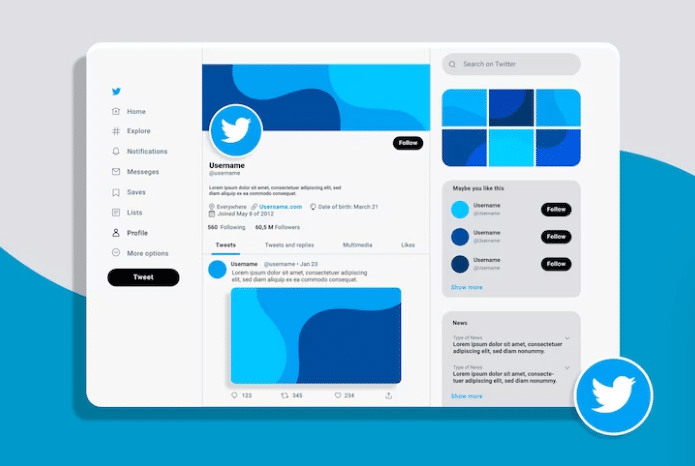
Consistency: Make sure that you use the same profile picture and bio across all platforms to create a consistent online identity.
Alignment: Your bio should communicate who you are, what you do, and what makes you unique. Highlight your value proposition and align it with your brand.
Visual Appeal: Choose visuals that resonate with your brand. Whether it’s a professional picture of yours or an eye-catching image, make sure it sets right with your narrative and appeals to your target audience.
Contact Information: Make sure that your contact details are easily accessible for those who wish to connect or collaborate with you. This will help you build meaningful connections and expand your network.
Why are Thoughtfully Designed Profiles Important for Personal Branding?
Profiles are incredibly important when it comes to personal branding as they are usually the first impression people have of you when they engage with you online. Therefore, it is essential to have a well-made profile that effectively communicates your brand identity, making it easier for others to comprehend and engage with you.
Sharing Your Content
Sharing your content is an important point of building your brand. To do so simply, you need to strategize your content creation and sharing. Here are some of the tips that’ll help you manage the world of content

Quality first: Always keep in mind quality over quantity when creating content. Your focus should be on producing high-quality content rather than a higher number of content, which should align with your expertise and relate to your audience. Compared to consistent offering, value is more important than frequent but shallow posts.
Content calendar: Create a content calendar that outlines topics, formats, and release dates. This ensures the growth of relevant content that keeps your audience engaged.
Engagement: Actively engage with your audience by responding to comments, asking questions, and participating in discussions related to your niche. This helps to build a relationship with your audience and establish yourself as a legitimate in your field.
Visual storytelling: Visual content, such as infographics or videos, can be powerful tools to convey complex ideas or tell interesting stories. Adding visual elements to your content can help you communicate your message more effectively and stand out from the crowd.
Why Does Content Play Such an Important Part in Personal Branding?
Your content and personality are displayed through your content, which acts as an instrument for communication. It helps you seize the opportunity to prove your worth, show off your abilities, and establish a much deeper connection with your audience.
Building Networks and Collaboration
You’re not alone in your niche there will be hundreds or thousands of others too so rather than considering them as competitors think of them as allies. Building alliances and collaborating with others can help you grow your brand’s reach. Here’s how:
Networking: Actively engage with individuals who share your interests or content. Connect with them, join relevant groups or forums, and participate in discussions.
Collaboration: Collaborate with others in your field for cross-match content, collaborative campaigns, live sessions, etc. Such partnerships introduce your brand to new audiences.
Guest Contributions: Contribute guest posts or articles to trusted websites or platforms in your niche. This expands your reach and positions you as an authority.
How Can Collaboration and Networking Promote Your Brand?
Collaboration and networking are like going on journeys with other experienced sailors. They stretch your perspectives, expose you to various audiences, and increase customer trust in your brand.
Tracking Your Brand’s Progress
It’s necessary to keep updated with your brand’s evolution as you grow in the world of social media.
Analytics, online reputation management, and feedback are all crucial components of a successful social media strategy. By monitoring key metrics like engagement rates and follower growth, you can gain insights into your audience’s behavior and make your content better according to their needs. Regularly searching for your name or brand online can help you address any negative feedback or issues quickly while asking for feedback from your audience can provide valuable insights for improvement.
Conclusion
Remember that growing your brand is constantly changing as we conclude. It involves creating a story that reflects your principles, openly sharing your knowledge, and getting involved with a community that connects with your message.
The secret to success lies in building relationships and developing a society with values of trust and loyalty. In addition, you must consistently communicate your message and work hard to improve the client experience. Finally, you must be open to criticism and use it to strengthen your brand.
Your personal brand is not just a virtual persona, it’s an ever-evolving legacy that you’re building. Always keep in mind that your brand acts as a guiding light, leading you toward a future where your unique personality and content shine bright on social media. As you continue to navigate through the vast horizon of social media, remember to stay genuine to your brand and let it be the driving force behind your online existence.
Expanding Your Social Media Presence, Ma
The world of social media can be overwhelming at times, with the constant allure of likes and comments on every post. But fear not, with the right strategies and understanding, you can improve your social media experience and build an active online audience around your content. In this article, we’ll share different tips and tricks to help you create engaging and interactive content that will boost your visibility on social media. By gaining more likes, comments, and followers, you can increase your reach and create an engaging social media presence.
Why is Engagement Important on Social Media?
Your social media engagement is the soul of your virtual presence. It means that your audience is actively engaging and interested in the content you provide. The connections, conversations, and relationships represented by likes and comments are more than just abstract numbers; they give your online personality life.
The Art of Engaging Content
To get more likes and comments on your content, it is essential to create content that relates to your audience. The first step to achieving this is by identifying your audience and understanding their preferences, desires, and the challenges they face. This knowledge will help you to create content that responds to their needs and desires.
Investing in visually appealing pictures of the highest standard can also help to attract your audience’s attention. Such images, movies, and visuals are more likely to make the scrolling thumb stop and engage with your content.
Another effective way to keep your audience engaged is by sharing narratives. You can tell stories, share personal experiences, and provoke thoughts and emotions through your content. By doing so, you can draw in viewers and keep them coming back for more.
Lastly, consistency is key. Keeping your posting routine constant and providing your audience with consistent, solid content will help keep them interested in your profile and increase engagement.
Making Genuine Connections
Meaningful engagement rests based on authenticity. Being authentic, creating authentic connections, and appreciating feedback from your audience are key elements of making an engaging crowd.
Responding actively: Respond to comments made by your audience right away and interact with them. Acknowledge and express your gratitude for their contributions.
Ask Questions: In your captions, propose interesting inquiries that encourage discussions and promote conversations. Encourage your audience to share their ideas and experiences.
Give a peek behind the scenes of your life or business. When your audience feels like they are a part of your journey, authenticity grows rapidly.
Thank Your Audience for Their Support and Feedback: Say thank you to your audience. The power of a simple “thank you” in building connections is tremendous.
Why is Social Media Participation Tied to Authenticity?
The thread that holds your audience to your content is authenticity. In your social media community, it promotes loyalty, trust, and a sense of connection.
How Crucial Timing is?
The timing of your posts has a significant effect on engagement numbers. It’s necessary to understand how your audience responds and when they are most interested.
Use social media analytics tools to find out when your audience is most engaged. Views define times when involvement was at its peak.
Try publishing at different times throughout the day and week as an experiment. Watch the engagement rates to figure out the ideal publishing timings.
If you are not online, use scheduling tools to make sure that your content is published when it is at its peak.
The Effectiveness of Hashtags
The online way posts that guide the audience to your content are hashtags. Make use of them wisely to increase your audience while promoting engagement.
Relevance: Pick hashtags that are relevant to both your content and your intended audience. Avoid using hashtags that are too general or overused.
Variety: Use a combination of hashtags that are both popular and specific. Your social media visibility is increased as a result of using these hashtags.
Think about creating a unique, specific-to-brand hashtag for your content. To establish a sense of belonging, and encourage your target audience to use it.
Cross-Promotion and Collaboration
Working together with other brands or persons of the same niche is often termed collaboration. Your content can reach new audiences by collaborating with influential people or brands that suit it.
Choose Partners: Decide which people or companies best fit your content or subjects. Look out for opportunities to work with others on projects or campaigns.
Cross-Promote: Spread the word about each other’s content by tagging one another in postings, conducting joint live sessions, or arranging giveaways
Make use of Guest posts: Allow partners or influencers to create posts for you or manage your account for a day. These strategies give birth to new perspectives.
Engaging Contests and Challenges
Contests and challenges promote the crowd’s excitement and participation. Create entertaining and engaging possibilities for comments and likes.
Photo Challenges: Encourage your audience to take part in contests that are centered around your specialty or theme. Convince them to use a particular hashtag that is made by you.
Run competitions requiring participants to post creative comments that were insightful. Give rewards to the most compelling ones.
Host trivia or quizzes that are connected to your content. Encourage audience members to give answers or comments.
Why Do Engagement Challenges and Contests Encourage Interaction?
Challenges and contests add an element of fun and competition, motivating your audience to actively engage with your content.
Monitor, Adapt, and Evolve
Engagement on social media is a constantly changing setting. Consider feedback from your audience, keep an eye on your stats, and adjust your strategies as applicable.
Review feedback from users and engagement metrics regularly while reviewing insights. Assess patterns, and then alter your posts and content tactics to them.
A/B testing: Use A/B testing to compare various strategies. Try with different captions, content genres, and posting times.
Be Informed: Keep yourself updated on changes to platform algorithms and social media trends. Adjust your tactics to make use of the latest specs.
Conclusion
Remember that the art of likes and comments is a constant journey as we come to conclude this article on the world of social media engagement. Create engaging content, prioritize authenticity, make use of scheduling and hashtags, analyze teamwork, and infuse fun with challenges and competitions. Keep track of your growth, adjust to the changing virtual fluctuations, and grow with your audience.
Your social media profile is a blank canvas for you to paint on, and interaction is the rich color combination that gives life to your blank canvas. By developing this skill, you can transform your online interaction into an exciting work of art, where each likes and comment acts as a brushstroke of friendship and connection.
Therefore, don’t be hesitant to express your creativity. Just bear in mind to keep a positive impression of yourself.
